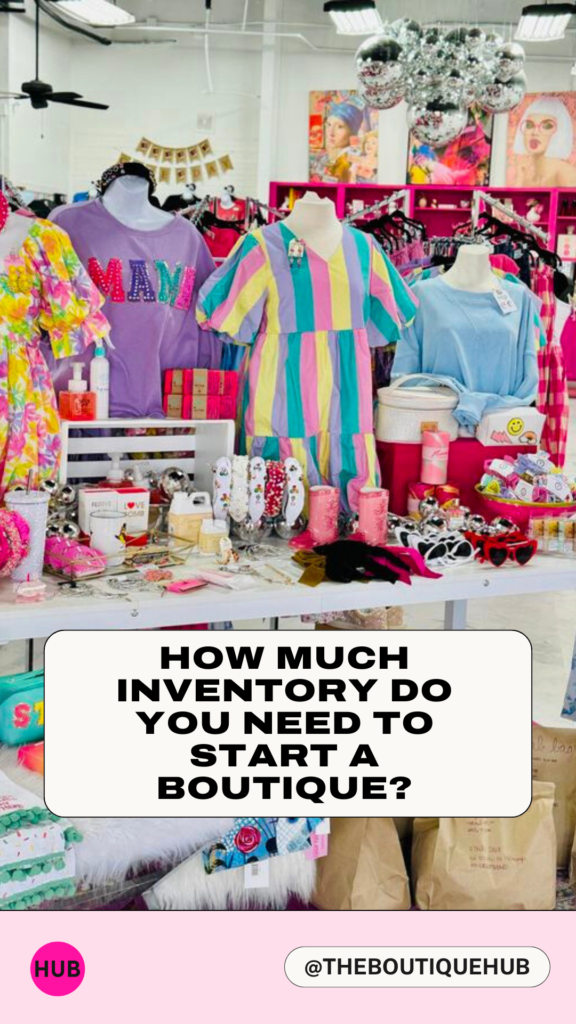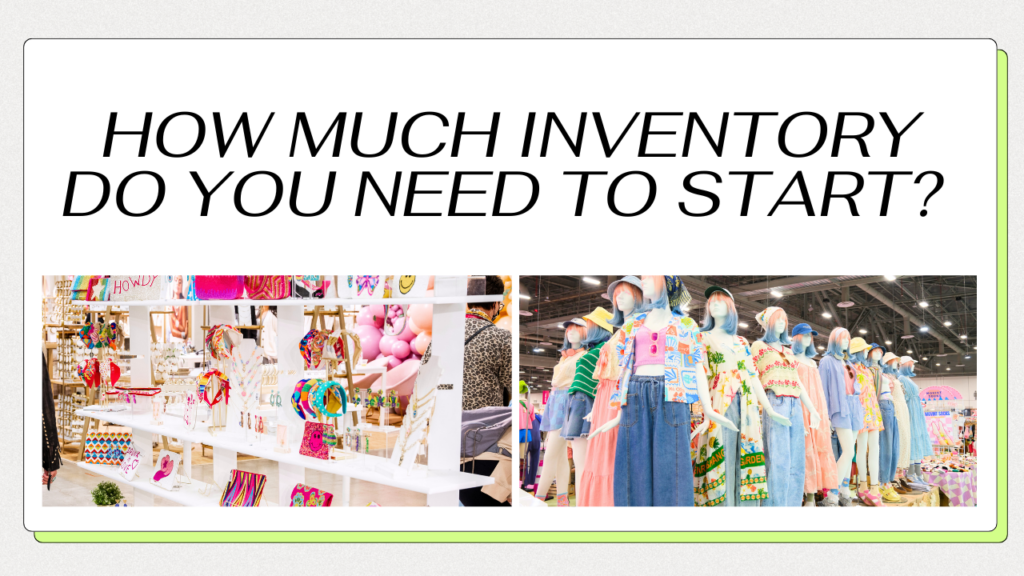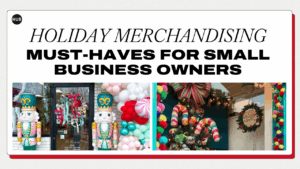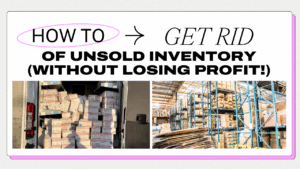Starting a boutique is an exciting venture, but one of the biggest questions new boutique owners face is: how much inventory do I need? The answer isn’t one-size-fits-all, as it depends on your business model, budget, and customer demand. However, having a strategic approach to inventory planning can set you up for success from day one.
Want an in-depth guide on determining the right amount of inventory to start with? Download our FREE guide here: How Much Inventory Do I Need to Start?

Factors to Consider When Buying Inventory
1. Your Boutique’s Business Model
- Brick-and-Mortar Boutique: If you’re opening a physical store, you’ll need enough inventory to fill your space without overwhelming it. A well-stocked boutique creates an inviting shopping experience, but too much inventory can lead to clutter and excess stock.
- Online Boutique: Without the constraints of a physical location, you can start with a smaller, curated selection. You may choose a pre-order or drop-shipping model to minimize upfront inventory costs.
- Pop-Up Shop or Market Events: If you’re selling at events or pop-ups, your inventory should be tailored to fit the theme, season, and expected foot traffic.
2. Determine Your Inventory Categories
To create a well-rounded boutique collection, start by breaking your inventory into key categories:
- Tops: Blouses, casual tops, sweaters, layering pieces, blazers
- Bottoms: Jeans, skirts, shorts, slacks
- Dresses: Casual, special occasion, seasonal, rompers
- Outerwear: Jackets, coats, vests
- Accessories: Scarves, hats, socks
- Jewelry: Necklaces, rings, bracelets
- Home Decor & Gifts: Candles, stationery, prints, baskets, journals, seasonal items
3. Establish an Inventory Breakdown
Where do you predict your sales to come from? A general rule for new boutiques is that 50% of your inventory should focus on the top half of the body, as these items tend to get more compliments and are easier to sell.
Here’s an example of a starting inventory budget allocation:
- Tops: 50%
- Jewelry: 15%
- Accessories: 15%
- Bottoms: 10%
- Outerwear: 5%
- Home Decor & Gifts: 5%
4. Start with Sales Projections
Estimate your first 3-6 months of sales based on expectations, market research, or similar businesses.
Use this formula to calculate projected monthly sales: Projected Monthly Sales = Average Order Value × Expected Foot Traffic or Online Orders
For example, if you expect 300 transactions per month at an average order value of $50, your projected monthly sales would be $15,000.
5. Determine Your Inventory Investment
Your starting inventory should be 2.5 to 3 times your projected monthly sales to ensure you have enough stock while allowing room for new arrivals.
For example, if your projected monthly sales are $30,000, your initial inventory should be valued at $75,000 – $90,000 at retail price. Depending on your markup, you can then determine your wholesale investment.
How to Avoid Overstocking
Buying too much inventory can tie up your cash flow and lead to markdowns. To prevent overstocking:
- Start with 1-2 packs per style and restock bestsellers.
- Use pre-order or waitlist strategies to gauge interest before making bulk purchases.
- Monitor sales trends and adjust your buying strategy accordingly.
Final Thoughts
Starting a boutique with the right amount of inventory requires a balance between variety and financial sustainability. Begin with a curated selection, track your sales, and adjust as needed. With strategic inventory planning, you can grow a successful boutique that keeps customers coming back for more!
Ready to take the guesswork out of inventory planning? Download our FREE guide here: How Much Inventory Do I Need to Start?
Need help sourcing inventory? Check out Hubventory for exclusive wholesale collections and trending styles perfect for your boutique!
Get more information on growing your business by joining The Boutique Hub where we have tons of training, strategies, and most importantly, connection! Try out our service for a month, cancel anytime.
- Turn Overstock Into Opportunity: How Max Retail Helps Boutique Owners Recoup Their Wholesale Costs
 Got past-season styles still sitting on your shelves? Max Retail helps boutique owners turn leftover inventory into cash—fast. With access to 400+ million shoppers across 20+ e-commerce sites, you can recoup your wholesale costs without slashing prices or risking your brand reputation. Read the full blog to learn how Max Retail is helping 2,500+ retailers like you sell smarter.
Got past-season styles still sitting on your shelves? Max Retail helps boutique owners turn leftover inventory into cash—fast. With access to 400+ million shoppers across 20+ e-commerce sites, you can recoup your wholesale costs without slashing prices or risking your brand reputation. Read the full blog to learn how Max Retail is helping 2,500+ retailers like you sell smarter. - Holiday Merchandising Must-Haves for Small Business Owners
 Seasonal merchandising during the holidays can make a significant difference in your business’s success. It’s not just about offering the right products; it’s also about creating a festive and inviting atmosphere that draws customers in and encourages them to make purchases. In this blog, we’ll explore some holiday merchandising essentials for small business owners, along with tips on why they are essential for your success.
Seasonal merchandising during the holidays can make a significant difference in your business’s success. It’s not just about offering the right products; it’s also about creating a festive and inviting atmosphere that draws customers in and encourages them to make purchases. In this blog, we’ll explore some holiday merchandising essentials for small business owners, along with tips on why they are essential for your success. - How to Get Rid of Unsold Inventory (Without Losing Profit!)
 If you’ve ever stared at a rack full of last season’s styles and thought, “What am I going to do with all this?” you’re not alone. Every boutique owner faces the challenge of managing slow-moving or unsold inventory. But the good news? That stock doesn’t have to collect dust or drain your cash flow. Inside… Read more: How to Get Rid of Unsold Inventory (Without Losing Profit!)
If you’ve ever stared at a rack full of last season’s styles and thought, “What am I going to do with all this?” you’re not alone. Every boutique owner faces the challenge of managing slow-moving or unsold inventory. But the good news? That stock doesn’t have to collect dust or drain your cash flow. Inside… Read more: How to Get Rid of Unsold Inventory (Without Losing Profit!) - Spring/Summer 2026 Fashion Trends: Your Boutique Buyer’s Guide to What’s Next
 Spring/Summer 2026 is all about effortless energy—airy silhouettes, soft pastels, and confident color play. From romantic lace and voluminous sleeves to elevated basics and utility details, this season blends femininity with function. Inside The Boutique Hub’s Spring/Summer 2026 Trend Report, you’ll find the key colors, prints, and styles shaping the season, plus wholesale brand recommendations to help you buy smart and curate with confidence.
Spring/Summer 2026 is all about effortless energy—airy silhouettes, soft pastels, and confident color play. From romantic lace and voluminous sleeves to elevated basics and utility details, this season blends femininity with function. Inside The Boutique Hub’s Spring/Summer 2026 Trend Report, you’ll find the key colors, prints, and styles shaping the season, plus wholesale brand recommendations to help you buy smart and curate with confidence. - Pink Friday Promotional Ideas
 Pink Friday is the small business spin on Black Friday, a nationwide movement to encourage shoppers to Support Small First. Whether you sell online, in-store, or both, this guide is packed with creative Pink Friday marketing ideas, in-store and online promotions, and collaboration tips to help you make Pink Friday your most successful sales day of the year. Get ready to plan, promote, and celebrate your small business in style!
Pink Friday is the small business spin on Black Friday, a nationwide movement to encourage shoppers to Support Small First. Whether you sell online, in-store, or both, this guide is packed with creative Pink Friday marketing ideas, in-store and online promotions, and collaboration tips to help you make Pink Friday your most successful sales day of the year. Get ready to plan, promote, and celebrate your small business in style!






